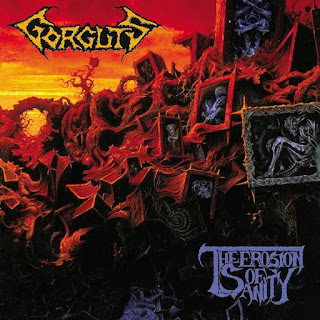Gorguts - "The Erosion Of Sanity" (1993)

W dokładnie dwa lata Kanadyjczycy z Gorguts uwinęli się z wydaniem "The Erosion Of Sanity" - następcy bardzo obiecującego "Considered Dead". Co ciekawe, przez ten niedługi czas, Luc Lemay i spółka mieli jednak dużo bardziej ambitne plany jeśli chodzi o dalszy kierunek w obrębie death metalu, wyraźnie odcinając się od planów na nagrywanie typowej kontynuacji jak to często zespoły miały w mniemaniu. W zasadzie, już przy pierwszej okazji Kanadyjczycy zboczyli w znacznie mniej oczywiste i wymykające się jednoznacznym porównaniom rejony ekstremy. W rejony ekstremy, gdzie pojawiły się dźwiękowe labirynty, a jednocześnie po raz pierwszy (ale nie ostatni!) ukazał się geniusz kompozytorski grupy Luca Lemaya.
Zmian w stosunku do "Considered Dead" jest więc bardzo dużo. Na "The Erosion Of Sanity" przeważa bowiem znacznie bardziej techniczny, brutalniejszy (czasem nasuwający skojarzenia z intensywnością i mieleniem rodem z Suffocation), pełen niebanalnych oraz poplątanych struktur death metal, który ozdobiono inną, skondensowaną i mało związaną z morrisoundowskimi standardami produkcją. Wszystkie te pomysły wyszły grupie jednak barrrdzo na plus, gdyż pozwoliło to zespołowi zaprezentować swój własny, unikalny styl, wyraźnie odmienny od kapel, na których wzorowano się jeszcze za - niedalekich - czasów "Considered Dead". Właściwie, drugi strzał Gorguts natychmiast wprawia w osłupienie od tego jak pomysłowe i nietuzinkowe jest to spojrzenie na death metal. Bo te sytuuje się tu jako mocno zakręcone, z niezwykle oryginalnymi aranżami gitar, wysuniętym do przodu basem (dodatkowo, niestroniącym od partii solowych, jak np. w "A Path Beyond Premonition"), z jeszcze bardziej rzygliwymi i histerycznymi wokalami Luca, dużą ilością klasowych solówek (tym razem w wykonaniu zarówno Lemaya, jak i Marcouxa), pełne przytłaczającej atmosfery oraz z ogólnie bardzo dużą dawką intensywności, choć niepozbawione pewnej czepliwości i ogromnej ilości motywów, które każą do siebie wracać. Przykładów nie trzeba daleko szukać, w te w gruncie rzeczy obfituje cała płyta, choć grzechem byłoby nie nadmienić w tym miejscu o "With Their Flesh, He'll Create", "Orphans Of Sickness", "Hideous Infirmity", "Condemned To Obscurity" czy tytułowcu. Przeskok jakościowy w porównaniu do "Considered Dead" jest tu na tyle wysoki, że tylko dziwi, iż taki materiał nie wzbił Gorguts do czołówki gatunku.
W każdym razie, na swoim drugim longplayu grupa Luca Lemaya uczyniła bardzo istotny progres oraz rozwinęła się w dużo bardziej ekstrawaganckie i nieoczywiste strony. Bo "The Erosion Of Sanity" to prawdziwa perełka w dziedzinie pokręconej ekstremy - płyta mocno zawiła i niełatwa w odbiorze, a jednocześnie esencjonalna pod kątem brutalności i ciężaru. "The Erosion Of Sanity" okazał się też być ostatnim wydawnictwem w pierwszym, oficjalnym składzie. Niedługo po premierze krążka, ekipę Gorguts opuścili bowiem wszyscy członkowie poza liderem, zaś sam Lemay zmuszony był skompletować zespół od nowa. I co ciekawe, pozwoliło mu to w przyszłości...poszybować jeszcze wyżej!
Ocena: 10/10
[English version]
In exactly two years, the Canadians from Gorguts released "The Erosion Of Sanity" - the successor to the very promising "Considered Dead". Interestingly, for this short time, Luc Lemay and the rest of the band had much more ambitious plans when it comes to the further direction within death metal, clearly rejecting themselves off from plans to record a typical continuation as bands often recorded. In fact, at the very first opportunity, Canadians focused into much less obvious and elusive comparisons to extreme regions. Into extreme regions, where sound labyrinths appeared and at the same time, for the first (but not the last!) time, the composing genius of Luc Lemay's group appeared.
So there are a lot of changes compared to "Considered Dead". "The Erosion Of Sanity" is dominated by much more technical and brutal (sometimes bringing associations with intensity and grinding straight from Suffocation) death metal full of original and tangled structures, which has much denser and not related to Morrisound standards production. All these ideas, however, came out very positive for the group, because the band presented their own, unique style, clearly different from the bands that were modeled on in the - not so distant - times of "Considered Dead". In fact, "The Erosion Of Sanity" immediately leaves you stunned by how inventive and unconventional this approach to death metal is. Because this approach is very twisted, with extremely original guitar arrangements, with much more audible bass (additionally, not avoiding solo parts, such as in "A Path Beyond Premonition"), with even more raucous and hysterical Luc vocals, a lot of classy solos (this time performed by both Lemay and Marcoux), full of overwhelming atmosphere and generally with a very high dose of intensity, although not devoid of a certain catchiness and a huge number of motifs that make you come back to this album. You don't have to look far for examples, the whole album abounds in them, although it would be a sin not to mention "With Their Flesh, He'll Create", "Orphans Of Sickness", "Hideous Infirmity", "Condemned To Obscurity" or the title track. The qualitative leap compared to "Considered Dead" is so high here that it's only surprising that such material did not take Gorguts to the forefront of the genre.
Anyway, on their second lp, Luc Lemay's group made a very significant progress and developed into much more extravagant and non-obvious sides. Because "The Erosion Of Sanity" is a real gem in the terms of twisted extreme - the album that is very complicated and not easy to listen to and at the same time essential in terms of brutality and heaviness. "The Erosion Of Sanity" also turned out to be the last release in their first, official line-up. Shortly after the premiere of the album, Gorguts left all members except the leader, and Lemay himself was forced to complete new line-up. And what's interesting, this caused...even more groundbreaking music in the following years!
Rating: 10/10



hellalujah :::
OdpowiedzUsuńArtificem commendat opus